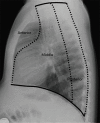Clinical approach to childhood mediastinal tumors and management
- PMID: 35118289
- PMCID: PMC8794350
- DOI: 10.21037/med-19-82
Clinical approach to childhood mediastinal tumors and management
Abstract
Mediastinal tumours are not uncommon in paediatric population and often pose a diagnostic challenge. They include a variety of entities including developmental, inflammatory, infectious and neoplastic; most are malignant. These lesions can be classified based on imaging according to the specific compartment (anterior, middle and posterior), generating a focused differential diagnosis. This combined with a rational, clinically oriented approach based on patient's history, focused physical examination, age, gender, symptoms, signs, anatomic localization, imaging characteristics and laboratory investigations including tumor markers paves way to a presumptive diagnosis guiding additional and prudent investigations. For example, a suspicion of lymphoma should be kept in a child presenting with a neck mass and superior vena cava syndrome. Neuroblastoma should be suspected among children younger than 5 years old with a posterior mediastinal mass. Such a structured approach along with histopathology will lead to an exact diagnosis. Surgery remains the mainstay of treatment of most benign and malignant non-lymphoid tumours. For optimal management, a combined modality of treatment incorporating chemotherapy and radiotherapy is often required in malignant tumours and is associated with high survival rates in these patients. In the present article, we review the approach to evaluation of mediastinal masses in childhood from a clinical perspective.
Keywords: Mediastinal; childhood; tumors.
2020 Mediastinum. All rights reserved.
Conflict of interest statement
Conflicts of Interest: All authors have completed the ICMJE uniform disclosure form (available at http://dx.doi.org/10.21037/med-19-82). The series “Pediatric Mediastinal Tumors” was commissioned by the editorial office without any funding or sponsorship. The authors have no other conflicts of interest to declare.
Figures




References
Publication types
LinkOut - more resources
Full Text Sources
